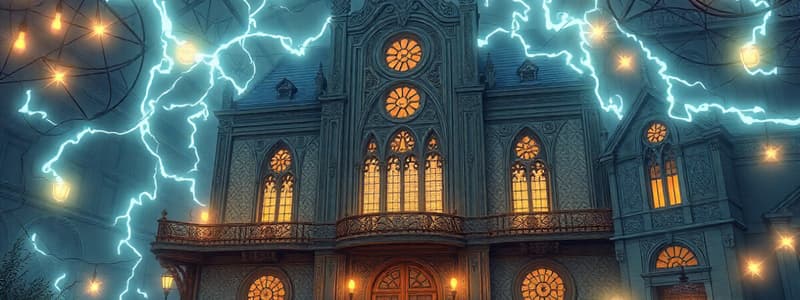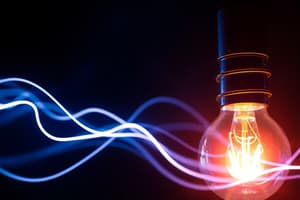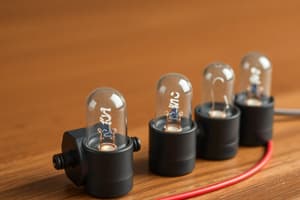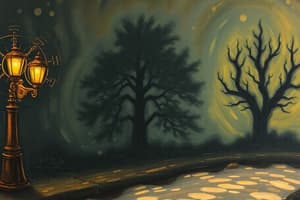Podcast
Questions and Answers
What is the unit of current measured in amperes defined as?
What is the unit of current measured in amperes defined as?
- The unit of energy
- The unit of voltage
- The unit of quantity or volume passing down a conductor (correct)
- The unit of power for an appliance
If an appliance requires 3kW of power, what is the corresponding fuse size used?
If an appliance requires 3kW of power, what is the corresponding fuse size used?
- 5 amp
- 10 amp
- 12.5 amp (correct)
- 15 amp
What is the unit of resistance that opposes the flow of current?
What is the unit of resistance that opposes the flow of current?
- Watt
- Ohm (correct)
- Volt
- Joule
What type of current is characterized as alternating current?
What type of current is characterized as alternating current?
How is electrical energy typically measured for billing purposes?
How is electrical energy typically measured for billing purposes?
In Ohm's Law, which formula describes the relationship between voltage, current, and resistance?
In Ohm's Law, which formula describes the relationship between voltage, current, and resistance?
For an appliance with a 5 amp fuse needing 1.2kW at 240V, what is the required voltage?
For an appliance with a 5 amp fuse needing 1.2kW at 240V, what is the required voltage?
What is the typical frequency of AC in the UK?
What is the typical frequency of AC in the UK?
What does the unit of power, watts (W), primarily indicate?
What does the unit of power, watts (W), primarily indicate?
If the resistance of a domestic appliance is 80 ohms and it has a current of 3 amps flowing through it, what is the voltage across the appliance?
If the resistance of a domestic appliance is 80 ohms and it has a current of 3 amps flowing through it, what is the voltage across the appliance?
Which of the following describes the difference between AC and DC currents?
Which of the following describes the difference between AC and DC currents?
What is the effective way to represent the relationship between voltage, current, and resistance using Ohm's Law?
What is the effective way to represent the relationship between voltage, current, and resistance using Ohm's Law?
If an appliance operates at 720 watts and the current draw is 3 amps, what would be the voltage supplied to the appliance?
If an appliance operates at 720 watts and the current draw is 3 amps, what would be the voltage supplied to the appliance?
Which unit is not typically used to measure electrical energy in contexts like electricity billing?
Which unit is not typically used to measure electrical energy in contexts like electricity billing?
What would the resistance be for a domestic appliance with a current rating of 0.2 amps and a voltage supply of 240 volts?
What would the resistance be for a domestic appliance with a current rating of 0.2 amps and a voltage supply of 240 volts?
What is the purpose of the anode and cathode in an electrical component?
What is the purpose of the anode and cathode in an electrical component?
Flashcards
Voltage (V)
Voltage (V)
The force that drives electrons to flow through a conductor. Measured in volts (V). Higher voltage means stronger force.
Current (I)
Current (I)
The amount of electrical current flowing through a conductor. Measured in amperes (A). Higher current means more electrons flowing.
Resistance (R)
Resistance (R)
The opposition to the flow of electrical current. Measured in ohms (Ω). Higher resistance reduces the flow of current.
Power (W)
Power (W)
Signup and view all the flashcards
Ohm's Law
Ohm's Law
Signup and view all the flashcards
Direct Current (DC)
Direct Current (DC)
Signup and view all the flashcards
Alternating Current (AC)
Alternating Current (AC)
Signup and view all the flashcards
Fuse
Fuse
Signup and view all the flashcards
What is Voltage?
What is Voltage?
Signup and view all the flashcards
What is Current?
What is Current?
Signup and view all the flashcards
What is Resistance?
What is Resistance?
Signup and view all the flashcards
What is Ohm's Law?
What is Ohm's Law?
Signup and view all the flashcards
What is Power?
What is Power?
Signup and view all the flashcards
What is Direct Current (DC)?
What is Direct Current (DC)?
Signup and view all the flashcards
What is Alternating Current (AC)?
What is Alternating Current (AC)?
Signup and view all the flashcards
What is a Fuse?
What is a Fuse?
Signup and view all the flashcards
Study Notes
Electricity Principles
- Electricity is the flow of electrons, and voltage is the electromotive force (emf) that causes electron flow.
- A higher voltage means a stronger force to move electrons through a conductor. Voltage is measured in Volts.
- Current (measured in amperes) is the rate of electron flow. Current is measured in Amperes.
- Resistance (measured in ohms) opposes the flow of current. Resistance is measured in Ohms (Ω).
- Power (measured in watts) is the rate at which electrical energy is used. Power is measured in Watts (W).
- Power is calculated by multiplying voltage and current. (P = VI, or Power= Voltage × Current)
- Electrical energy is measured in joules; electricity bills use kilowatt-hours. Energy is measured in Joules (J).
- Ohm's Triangle relates voltage, current, resistance, and power in a triangular schematic. This triangle helps determine how to find any unknown variable relating to these concepts. (P =I×V; I =P÷V; V = P÷I)
AC and DC Current
- AC (alternating current) changes direction periodically, like mains electricity (220-240 Volts AC, 50 Hz).
- DC (direct current) flows in one direction, like batteries (12-24 Volts DC).
- AC is generated electromagnetically and DC is chemical. This means that the alternating current (AC) is generated by electromagnetic fields while the direction current (DC) is produced by chemical reactions.
- Dissimilar metals in a dilute acid solution result in a chemical reaction which causes cathode metals to eat away the anode metal.
Electrical Components
- Anodes are positive terminals; cathodes are negative terminals in electrical systems.
- Anode and Cathode are the opposite electric poles in a circuit (either AC or DC).
- The cathode in an electrolytic system will gradually break down the opposite pole which we call an anode.
Activity 1
- Calculate fuse size needed for 3kW appliance: 12.5 amps
- Calculate maximum power rating for 3 amp fuse: 600 Watts or 0.6 kilo-watts (kW)
- Calculate voltage required for 5 amp fuse and 1.2kW power: 240 volts. This is a typical domestic voltage.
Ohm's Law
- Ohm's Law shows the relationship between voltage (V), current (I), and resistance (R).
- Ohm's Law triangle visually shows how to calculate these variables.
Activity 2
- Calculate resistance of a 3 amp fuse: Cannot be determined without knowing the voltage.
- Calculate fuse size for 1,200 ohms resistance: Cannot be determined without knowing the voltage.
- Calculate Voltage for 13 amp fuse and 32 ohms resistance: 416 volts. This is a calculation using Ohm's law.
Additional Information
- AC is typically designated as 220-240 Volts AC, 50 Hz.
- DC can be 12-24 Volts DC.
- Symbols are used to represent AC and DC (see image).
Studying That Suits You
Use AI to generate personalized quizzes and flashcards to suit your learning preferences.




